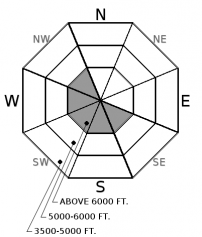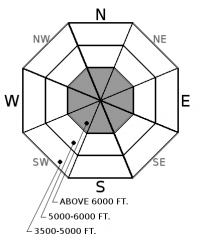| Thursday | Thursday Night | Friday | |
|---|---|---|---|
| Cloud Cover: | Partly to mostly cloudy skies | Clear and cold, strong valley inversions | Increasing clouds in the afternoon |
| Temperatures: | 15 to 20 deg. F. | -7 to -2 deg. F. | 15 to 20 deg. F. |
| Wind Direction: | NE to E | SE | SW |
| Wind Speed: | 0 to 5 mph | 0 to 5 mph | 10 to 15 mph, gusts 20 mph |
| Snowfall: | 0 in. | 0 in. | 0 in. |
| Snow Line: |
Whitefish Range
Swan Range
Flathead Range and Glacier National Park
How to read the forecast
Continued benign weather is allowing the upper snowpack to consolidate and gain strength. Lingering wind slabs remain a concern on isolated, leeward slopes at upper elevations. Pockets of unstable snow can be identified by shooting cracks or audible collapses. The best riding conditions and safest conditions exist on wind-sheltered slopes.

2. Moderate
?
Above 6500 ft.
1. Low
?
5000-6500 ft.
1. Low
?
3500-5000 ft.
- 1. Low
- 2. Moderate
- 3. Considerable
- 4. High
- 5. Extreme
-
Type ?
-
Aspect/Elevation ?

-
Likelihood ?CertainVery LikelyLikelyPossible
 Unlikely
Unlikely -
Size ?HistoricVery LargeLargeSmall

Thick, dense slabs and lens-shaped pillows formed on leeward slopes and cross-loaded terrain features at upper elevations over the weekend. These slabs formed in atypical locations from strong northeast winds. Observations from earlier in the week of collapses and shooting cracks emphasize the potential for human triggering. However, direct snowpack feedback decreases with time as these slabs become more stubborn to human triggers. Avoid pillow shaped drifts of thicker snow and look for cracking in the snow surface to manage this problem.
-
Type ?
-
Aspect/Elevation ?

-
Likelihood ?CertainVery LikelyLikelyPossible
 Unlikely
Unlikely -
Size ?HistoricVery LargeLargeSmall

Deep slabs remain a low likelihood, high consequence problem in our snowpack. Several deep, hard slabs failed naturally during our last storm cycle in the Flathead Range confirming this problem hasn’t gone to bed and demands your respect. The common theme remains, deep slabs are most likely triggered from shallow, rocky terrain or cornice falls in alpine terrain. Choose well-supported slopes with deep, uniform snow cover while traveling at higher elevations. This blog post provides more insight into the problem.
The last four days of benign weather is allowing the upper snowpack to consolidate and gain strength. However, cold temperatures make this process happen slowly and immediate changes can’t be expected overnight. As the snowpack finds a happy medium, we can’t forget about the most recent facet/ crust combo buried 1 to 2 feet deep. For today, wind slabs remain our primary avalanche problem. These slabs are becoming stubborn to human triggers and direct snowpack feedback such as collapses and shooting cracks are becoming limited to non-existent. Thick slabs formed over our most recent crust/ facet combo compound this problem and are most likely found at upper elevations on leeward and cross-loaded terrain features.
Imagine that, deep slabs remain a topic of conversation around the campfire. The Thanksgiving facet/ crust combo continue to rear its ugly head during each loading event and this last one was no exception. Observers spotted several destructive deep slab avalanches that ran on the SE face of Mt. Adams and SW face of Great Northern. This is direct confirmation that our deep slab problem demands respect and shouldn’t be messed with. Avoiding steep, rocky terrain or unsupported slopes at higher elevations is the best way to manage this complex and unpredictable problem. Many savvy backcountry travelers are avoiding these types of slopes and know that spring is just around the corner.
Our avalanche danger has trended downward over the past few days. Lower danger doesn’t mean NO danger and a holistic approach should be taken when evaluating slope specific stability. When building a box, you use several tools in the toolbox to give it the perfect dimensions. Same goes for assessing slope stability, don’t hedge your bet on one piece of information but incorporate all components and look at the bigger picture. Hunt for wind-sheltered slopes which offer softer snow, the best riding conditions, and safest skiing or riding.
Light southwest to southeast flow is observed across northwest Montana this morning. A deep trough and low-pressure system dig through the southwestern Great Basin taking precipitation well to our south for today and tomorrow. Generally, light winds and cold temperatures will persist for the next 36 hours before a more active weather pattern returns over the weekend.
This advisory applies only to backcountry areas outside established ski area boundaries. This advisory describes general avalanche conditions and local variations always occur. This advisory expires at midnight on the posted day unless otherwise noted. The information in this advisory is provided by the USDA Forest Service who is solely responsible for its content.































